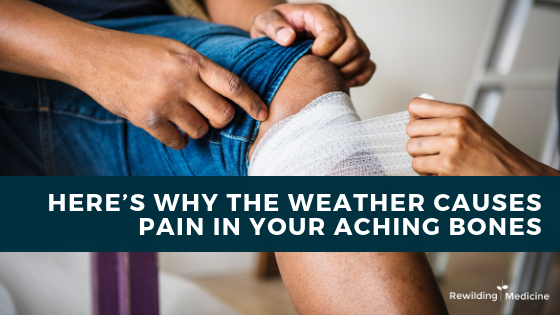When you were a child, do you remember elderly folks in your community complaining about the pain in their aching joints when the weather changed? Well there’s good reason.
In Traditional Chinese Medicine climactic and seasonal changes can be a cause of disease (read more about that here). External factors, like wind, damp, cold, and heat, can invade the body’s exterior and then cause dysfunction of all sorts. The joints that typically ache with weather changes are a particular type of pain pattern.
Acupuncturists refer to this joint-related pain as Bi Syndrome (or Arthralgia Syndrome). The word “Bi” itself translates as “obstruction“. In other words, things are not flowing smoothly in the body, so pain arises. Specifically, the external pathogenic factors (mentioned above) get inside the body and obstruct the free flow of qi and blood in the meridians. (If those terms are unfamiliar don’t sweat it, we’ll cover more on that elsewhere. If you’re hankering to learn more about that now, feel free to check out my free video series HERE.)
There are 6 types of Bi Syndrome:
1. Wind Bi
2. Cold Bi
3. Damp Bi
4. Heat Bi
5. Blood Stasis Bi
6. Heart Bi
The first three are most relative to what we’re talking about here. Here’s a quick breakdown of those:
1. Wind Bi (or Wandering Arthralgia) – tends to move around in the body without a fixed location, the pain can come and go, and the person may have a strong aversion to wind
2. Cold Bi (or Painful Arthralgia) – often a severe, stabbing pain, has a fixed location in the body, is made worse with cold weather and better with heat
3. Damp Bi (or Fixed Arthralgia) – usually joints that are sore and painful with swelling, worse on cloudy and rainy days, person has a greasy or sticky layer on their tongue
As you can see, not all pain is created equal.
Therefore, how we approach or manage pain also varies significantly. For example, while a conventional doctor may prescribe the same medication for anyone with knee pain, an acupuncturist will provide different herbs, diet recommendations, and acupuncture prescriptions based on which pattern fits that patient best.
All in all, it’s the type of external pathogenic factor present that determines the nature of someone’s pain. That’s why your grandfather was complaining about his aching joints when a storm was brewing. Chances are his was a Damp Bi pain that was made worse when the moisture levels and barometric pressure changed in the air.
Next time you have an aching joint, maybe think about the quality and nature of that pain. Is it Wind, Cold, or Damp Bi pain? (And by the way, know that you have many more options than just pharmaceuticals to manage pain.)
P.S. If you want to learn more about Traditional Chinese Medicine, then CLICK HERE to check out my FREE 3-part video series on eastern medicine!
Sign up for Sean’s FREE 3-part video training series to learn the basic body wisdom of Traditional Chinese Medicine.


